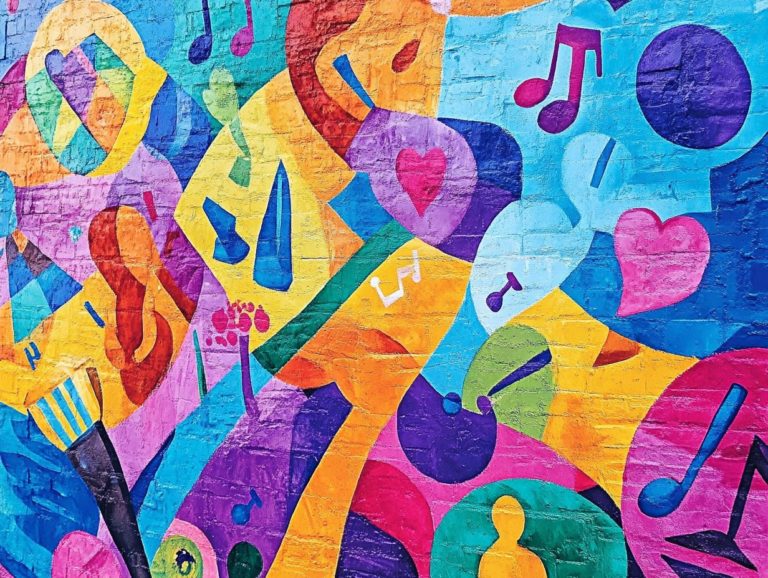cultural etiquette: what every language learner should know
Cultural etiquette plays a crucial role in effective communication, particularly for language learners like you.
Grasping the nuances of various cultures sharpens your language skills and cultivates meaningful connections. This article delves into what cultural etiquette is, its importance in your language learning journey, and how it shapes social interactions.
You ll discover key elements such as language, gestures, and customs. You’ll also learn about common pitfalls to avoid and practical tips for navigating cultural differences.
Embrace these insights to enhance your language learning journey and foster better relationships along the way.
Contents
- Key Takeaways:
- Understanding Cultural Etiquette
- The Impact of Cultural Differences on Language Learning
- Key Elements of Cultural Etiquette
- Avoid These Common Mistakes!
- Essential Tips for Navigating Cultural Differences!
- Benefits of Understanding Cultural Etiquette
- Frequently Asked Questions
- What is cultural etiquette and why is it important for language learners to know?
- What are some general rules of cultural etiquette that every language learner should know?
- How can I learn about cultural etiquette in specific countries or regions?
- What should I do if I accidentally offend someone due to a cultural etiquette mistake?
- How can knowing cultural etiquette benefit me as a language learner?
- Does cultural etiquette vary within the same language?
Key Takeaways:

- Cultural etiquette is essential for language learning because it impacts relationships and communication.
- Language learners should be aware of how cultural differences affect their journey.
- Understanding key elements such as language, gestures, and customs can help you navigate cultural differences and avoid common mistakes.
Understanding Cultural Etiquette
Understanding cultural etiquette helps you build meaningful connections in English-speaking countries. Good manners and politeness are key in social interactions.
Distinct cultural contexts influence how you communicate, especially in social situations like greetings, farewells, appropriate gestures, and language nuances.
By enhancing your cultural awareness, you can navigate diverse interpersonal relationships more effectively. This ability leads to successful interactions in various settings.
The Impact of Cultural Differences on Language Learning
Cultural differences greatly impact your language learning experience. This is especially true in English-speaking countries.
Understanding cultural etiquette enriches your language skills and elevates your overall communication.
As you immerse yourself in various dialects, accents, and cultural references, your ability to connect with others improves. This is greatly enhanced by your awareness of cultural nuances and politeness norms.
How Cultural Etiquette Can Affect Language Learning
Cultural etiquette is important in your language learning journey. Understanding the importance of cultural sensitivity in language learning sets the stage for how you engage with politeness norms and communication strategies in English-speaking countries.
Grasping the appropriate use of first names, showing respect when greeting elders, and appreciating a gentle handshake can enhance your ability to understand and interact well with different cultures.
For instance, navigating the nuances of initiating conversations is crucial. A simple “How are you?” can shift from a casual greeting to a more genuine interaction, depending on the context.
Mastering non-verbal cues, like maintaining eye contact during discussions, conveys confidence and interest essential for building rapport.
Understanding the etiquette around turn-taking in dialogue, especially in group settings, reflects deeper cultural values. It also influences how effectively you communicate your messages.
By adapting your language skills to these social dynamics, you foster meaningful interactions, enriching your ability to communicate effectively across diverse cultural landscapes.
Key Elements of Cultural Etiquette

Key elements of cultural etiquette include language, gestures, and social customs that differ across English-speaking countries. All of these play a crucial role in effective communication and fostering respectful interactions.
By understanding suitable greetings, farewells, and polite expressions, you enhance your ability to build meaningful connections in diverse social contexts.
Grasping these nuances is essential for navigating the rich tapestry of human interaction.
Language, Gestures, and Social Customs
Language, gestures, and social customs are key to understanding how to behave in different cultures. They reflect the unique values and beliefs of each culture.
For instance, in some English-speaking countries, a simple yet firm handshake serves as the standard greeting. In others, verbal assurances may carry more significance than written agreements.
This complexity often leads to misunderstandings. In Japan, bowing shows respect and indicates social rank. In the United States, maintaining eye contact during conversations signifies sincerity.
If you’re not familiar with this, you might misinterpret a lack of eye contact in Japan as disinterest or evasion.
A thumbs-up is widely accepted in many Western cultures but can be considered offensive in regions such as the Middle East. These cultural discrepancies emphasize the necessity of appreciating and adapting to these nuances, enhancing your interpersonal relationships and facilitating smoother communication.
Avoid These Common Mistakes!
Common mistakes in cultural etiquette often arise from a limited understanding of good manners and the subtle nuances tailored to various social contexts.
Overlooking the significance of greetings, appropriate gestures, or the weight of verbal commitments can lead to cultural faux pas that undermine respectful interactions.
Being aware and considerate of these elements can greatly enhance your connections with others.
Watch Out for These Faux Pas!
Examples of cultural faux pas can vividly show the pitfalls of misinterpreting politeness norms and social customs, especially when talking with people from different cultures.
For example, addressing someone by their first name without their permission may be seen as disrespectful in certain contexts.
In many Asian cultures, using formal titles is a hallmark of respect, while in casual Western environments, it’s common to be on a first-name basis.
Another instance to consider is pointing; in some cultures, particularly in parts of Southeast Asia, it’s impolite to point with a single finger. Using your whole hand is the preferred approach.
Misunderstandings can block effective communication and lead to discomfort that hinders relationship-building. Being mindful of these differences is crucial for fostering mutual respect and understanding in diverse interactions.

Navigating cultural differences demands effective strategies that promote awareness and cultivate respectful communication.
By grasping the importance of polite expressions, appropriate gestures, and the varying perceptions of time across cultures, you can significantly enhance your ability to connect with others in diverse environments.
Embracing these insights not only enriches your interactions but also fosters deeper relationships with people from all walks of life.
Communicate with Respect: Key Strategies!
Strategies for communicating respectfully across cultures include actively listening, being attuned to non-verbal cues, and tailoring your language to fit different cultural contexts.
Recognizing that time holds significant value in many cultures can also guide how you approach appointments and deadlines in your interpersonal interactions.
Understanding cultural nuances opens the door to more meaningful dialogues, allowing you to connect on a deeper level.
For example, practicing patience and refraining from interruptions can convey respect, especially in cultures where conversations follow a different rhythm.
Emphasizing empathy and seeking clarification when faced with cultural references can help bridge gaps in understanding.
In diverse environments, fostering an atmosphere of openness and curiosity not only enhances dialogue but also encourages the sharing of unique perspectives.
This cultural awareness ultimately shapes effective relationships by minimizing misunderstandings and creating an inclusive environment where everyone feels valued.
Benefits of Understanding Cultural Etiquette
Understanding cultural etiquette offers you a wealth of benefits, from strengthening relationships to enhancing your understanding of different cultures and improving communication in diverse settings.
By recognizing and appreciating cultural differences, you can build strong connections that go beyond language barriers and social customs. This awareness transforms your interactions into exciting opportunities and gives you the power to navigate various environments with confidence and grace.
Improved Relationships and Communication
Understanding cultural etiquette directly enhances your relationships and communication skills. It allows you to navigate social dynamics with finesse and employ effective language skills. This heightened awareness fosters increased trust and respect in both your personal and professional interactions.
Consider a collaborative project between an American tech firm and a Japanese company. This example illustrates the power of cultural understanding. The American team initially encountered challenges due to misunderstandings about the indirect communication styles common in Japanese culture.
They improved after participating in cultural sensitivity training. They came to appreciate the significance of non-verbal cues and hierarchical structures, which markedly improved their interactions. As a result, both teams experienced a notable increase in project efficiency and innovation, demonstrating that when diverse cultural backgrounds are respected, collaboration truly thrives.
Frequently Asked Questions

What is cultural etiquette and why is it important for language learners to know?
Cultural etiquette refers to the customs and behaviors that are expected and considered appropriate in a particular culture. It is important for language learners to know because it helps them navigate social interactions and avoid unintentionally causing offense or misunderstandings.
What are some general rules of cultural etiquette that every language learner should know?
Some general rules include showing respect for elders, avoiding sensitive topics, and being mindful of personal space.
How can I learn about cultural etiquette in specific countries or regions?
One way to learn is to research the customs and expectations in a particular culture. You can also ask native speakers or people who have lived in that culture for advice and guidance.
What should I do if I accidentally offend someone due to a cultural etiquette mistake?
If you accidentally offend someone, the best approach is to apologize sincerely. Explain that you were unaware of the cultural norms. This shows your willingness to learn and respect the culture.
How can knowing cultural etiquette benefit me as a language learner?
Knowing cultural etiquette enhances your communication skills and helps you build positive relationships with native speakers. It also shows that you are culturally sensitive and respectful, which can make a good impression and open doors for new opportunities.
Does cultural etiquette vary within the same language?
Yes, cultural etiquette can vary within the same language. Different regions or countries may have different customs and expectations, so it is essential to be aware of these differences and adapt accordingly.
Start your journey into cultural etiquette today!






